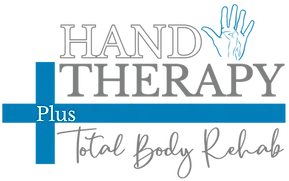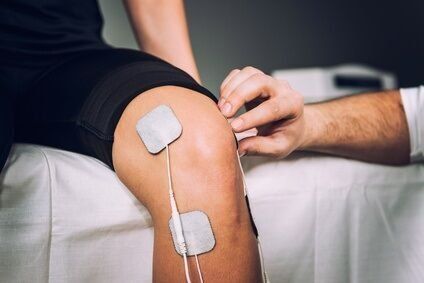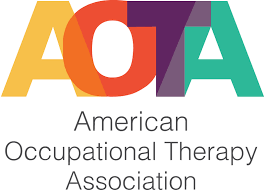Chronic Pain
Chronic Pain
Pain (an unpleasant sense of discomfort) that persists or progresses over a long period of time. In contrast to acute pain that arises suddenly in response to a specific injury and is usually treatable, chronic pain persists over time and is often resistant to medical treatments.
Chronic pain may be related to a number of different medical conditions including, but not limited to diabetes, arthritis, migraine, fibromyalgia, cancer, shingles, sciatica, and previous trauma or injury. Chronic pain may worsen in response to enviormental and/or psychological factors.
Nonpharmacologic treatments for chronic pain can include: exercise, physical/occupational therapy, electrical stimulation, biofeedback, dry needling, myofascial release, cupping, and other alternative treatments.
What is Myofascial Release?
Ashlee Hicks, COTA/L, performing MFR to relieve back pain.
MFR is a safe and very effective hands-on technique that involves applying gentle sustained pressure into the Myofascial connective tissue restrictions to eliminate pain and restore motion.Trauma, inflammatory responses, and/or surgical procedures create fascial restrictions that can exert tremendous tensile pressures on pain sensitive structures that do not show up in many of the standard tests. MFR is a successful, alternative method to relieving chronic pain symptoms.
What is Instrumental Soft Tissue Mobilization?
Instrument Assisted Soft Tissue Mobilization (IASTM) is a skilled intervention used for soft tissue treatment. It includes the use of specialized tools to manipulate the skin, myofascia, muscles, and tendons by various direct compressive stroke techniques. The instruments effectively break down scar tissue and adhesions.
Common soft-tissue injuries usually occur from a sprain, strain, blow to the body resulting in a contusion (ruptured blood vessels/bruising), or overuse of a particular body part. Soft tissue injuries can result in pain, swelling, bruising and loss of function. Adhesions within the soft tissue may develop as a result of repeated strain, surgery, immobilization or other mechanisms.
Dry Needling
Dry needling is the insertion of thin monofilament needles, as used in the practice of acupuncture, without the use of injectate into muscles, ligaments, tendons, subcutaneous fascia, and scar tissue. Dry needles may also be inserted in the vicinity of peripheral nerves and/or neurovascular bundles in order to manage a variety of neuromusculoskeletal pain syndromes.
Cupping
Cupping therapy is a practice that involves briefly applying rounded inverted cups to certain parts of the body using a vacuum effect. Some proponents suggest that the drawing of the skin inside the cups increases blood flow to the area.
Cupping is often recommended as a complementary therapy for the following conditions:
- Back pain
- Headache or migraine
- Knee pain
- Muscle pain and soreness
- Neck and shoulder pain
- Sports injuries and performance
Transcutaneous Electric Nerve Stimulation (TENS)
TENS variations are often described by their technical characteristics: high frequency, low intensity (conventional TENS) or low frequency, high intensity (acupuncture-like TENS, AL-TENS).
How TENS Addresses Pain:
- A gate consisting of excitatory and inhibitory synapses that exist in the dorsal horn of the spinal cord regulates the amount of nociceptive traffic (painful stimuli) transmitted to the brain. This gate could be closed by non-noxious stimuli (e.g. touch, pressure and electrical currents), and block potential nociceptive stimuli.
- Increased release of endorphins through heat transmission, possibly more localized to the area of the pain
- Physiologically, conventional TENS selectively activates non-noxious low threshold afferent nerve fibers in the skin (Aβ-fibers). When administering TENS, Aβ nerve fiber activity is reported by the client to feel like a strong electrical paresthesia (pins and needles) beneath the electrodes. AL-TENS is intended to generate a muscle twitch to activate small diameter afferent nerve fibers in muscles (Aδ) and descending pain inhibitory pathways. AL-TENS is administered at low frequency and high intensity currents over muscles, without pain.
Inferential current (IFC)
Developed in the 1950s, IFC is most commonly used for pain relief. IFC is also claimed to reduce inflammation, assist tissue repair (including bone fractures), and reeducate muscle.
How IFC Addresses Pain:
- IFC delivers current to deep-seated structures through an amplitude-modulated interference wave typically with the use of four electrodes.
- The wave is created by two out of phase currents that collide with each other to generate an interference with a frequency that can penetrate through the skin to deeper structures and even excite neurons.
- Use of IFC should generate a strong but comfortable electrical paranesthesia at the site of the pain, to generate Aβ activity.





